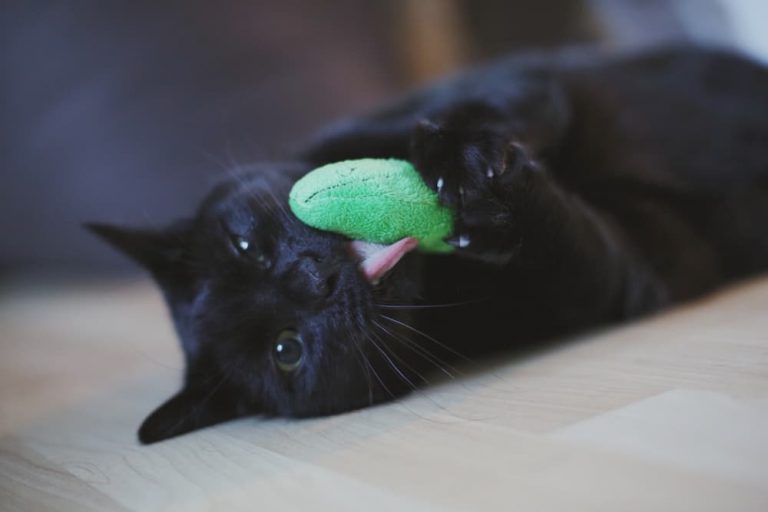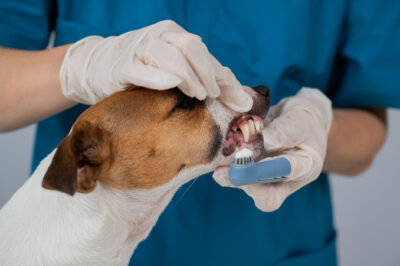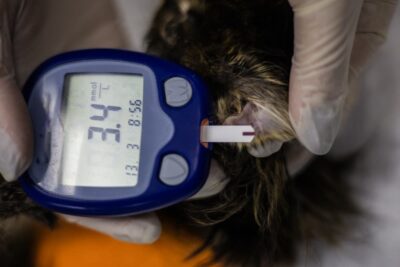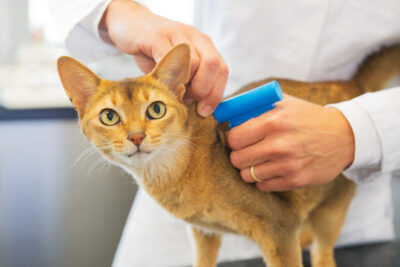Silver Vine for Cats: Benefits and Safety Information

Cats have a very strong sense of smell, which makes olfactory enrichment with cats a great way to easily enhance their environment to support optimal emotional and even physical health.
Certain plants can elicit responses like euphoria or excitement with cats. A common example is catnip, but 1 out of 3 cats do not respond to the chemicals produced by catnip. In these cases, silver vine for cats may be a better option.
Learn more about what silver vine is, how it affects cats, the potential benefits, and how to use it safely to enhance your cat’s environment.
What is Silver Vine?
Silver vine, also known as Actinidia polygama or matabi, is a species of kiwifruit that is native to the mountainous regions of China, Japan, Korea, and eastern Russia. The leaves are adorned with silvery white tips, which is how the plant got its name. It is a fast-growing vine that also produces edible bright orange fruits in early fall and beautiful white flowers in early summer.
In humans, silver vine has been used medicinally for centuries as an alternative therapy to treat hypertension, arthritic pain, and even cystitis.
Silver vine meant for felines comes from the dried vine twigs themselves or a powder that is produced from grinding the dried fruit galls. Cats respond most to the powder form due to it being more concentrated. When purchasing silver vine, it’s important to make sure it’s organic to reduce the risk of chemicals that can adversely affect a cat’s health.
Benefits of Silver Vine for Cats

Typically two questions top the list when it comes to introducing silver vine to cats. Is silver vine good for cats? And more importantly, is silver vine safe for cats? The answer to both is a resounding yes. There are many benefits of giving silver vine to cats, and it isn’t harmful to do so.
Silver vine is a great environmental enrichment tool for cats. Many cats are indoor only, making environmental enrichment important. Cats kept indoors can easily become more bored and stressed than cats that roam freely outdoors. This can lead to behavioral problems or even physical health conditions like urinary issues and obesity. Olfactory stimulation is often overlooked as a way to enrich a cat’s environment, yet it’s easy to do with plants like silver vine.
Providing your kitty with silver vine cat toys helps stimulate their natural prey drive and encourage play behavior. This is essentially important for indoor cats to reduce stress and behavior problems that can come from not engaging in their natural high prey drive behaviors.
Using silver vine sticks is a great, natural way to support dental health. Because of the chemicals present in the silver vine stick, cats want to chew and gnaw, which helps reduce tartar buildup on their teeth and encourages a healthy mouth. Brushing a cat’s teeth can be difficult for many, so using silver vine twigs not only provides environmental enrichment through olfactory stimulation, but also offers an easier way to keep your cat’s gums and teeth healthy.
Silver Vine Effect on Cats

When cats sniff certain plants, the plants’ allomones (chemicals) can elicit specific responses. Nepetalactone is the dominant compound found in catnip that cats react to with an immediate behavior change.
In contrast, silver vine contains several compounds, including actinidine, iridomyrmecin, isodihydronepetalactone and its isomers, along with a small concentration of nepetalactone.
When these compounds are inhaled, they stimulate the sensory neurons present in the nasal tissue of the cat. These sensory neurons then stimulate the olfactory bulb, which is connected to other regions in the brain that cause the stimulatory behavior reactions displayed by cats after being exposed to silver vine.
Some of the silver vine effects on cats include:
- Rolling around
- Meowing
- Drooling
- Staring into space
- Generally acting more playful
Typically the reactions begin immediately after silver vine exposure and last for about 30 minutes. Older cats seem to have a stronger response than younger cats, and the response can also vary depending on the form of silver vine used. A powdered form tends to be most concentrated, while silver vine sticks produce less of a response due to varying concentrations of the aforementioned compounds.
Silver vine is generally very safe, but make sure to monitor your cat while using silver vine to watch for adverse reactions.
Can Cats Get Addicted to Silver Vine?
The data for understanding whether cats can become addicted to silver vine is limited. However, the benefits of using silver vine to enrich a cat’s environment outweigh not using it. There are also currently no cases where a cat overdosed or was harmed by using silver vine.
How to Use Silver Vine for Cats

Many pet stores and online vendors sell silver vine in various forms, ranging from silver vine cat toys to silver vine sticks and silver vine powder for cats.
Growing silver vine can be done most easily by placing it in a hanging basket near a cat tower, with vines touching the cat condo to allow the cat to self-select the plant when they want. Silver vine can also be trained to grow up a trellis if your kitty has access to a catio. Silver vine plants for cats are easy to maintain by pruning the vines.
Choosing organic products and plants are ideal to reduce toxin exposure and keep your cat safe. When shopping online for silver vine, make sure to read the reviews for different products, and if not listed in the description, contact the supplier to ask where the product was sourced and if it is organic.
If your cat prefers a silver vine stick, make sure to monitor them while they’re chewing the stick to prevent larger pieces from being bitten off and swallowed. The silver vine stick lining also needs to be peeled back prior to being given to the cat, and the label for the product should have instructions for doing so.
There are many ways to use this plant to help enhance their environment, improve their prey drive, reduce stress, and optimize their health. Bottom line: silver vine is a safe and fun plant to bring into the house for cats of all ages to enjoy.
Resources
- Bol S, Caspers J, Buckingham L, et al. Responsiveness of cats (Felidae) to silver vine (Actinidia polygama), Tatarian honeysuckle (Lonicera tatarica), valerian (Valeriana officinalis) and catnip (Nepeta cataria). BMC Veterinary Research. 2017;13. doi:10.1186/s12917-017-0987-6.
- Leyhausen P. Addictive behavior in free ranging animals. In: Psychic dependence. edn. Edited by Goldberg L, Hoffmeister F. New York, Heidelberg, Berlin: Springer-Verlag; 1973. p. 58–64.
- Sakan T, Fujino A, Murai F, Butsugan Y, Suzui A. On the structure actinidine and matatabilactone, the effect components of Actinidia polygama. Bull Chem Soc Jpn. 1959;32:315–6.
- Uenoyama R, Miyazaki T, Hurst JL, et al. The characteristic response of domestic cats to plant iridoids allows them to gain chemical defense against mosquitoes. Science Advances. 2021;7(4):eabd9135. doi:10.1126/sciadv.abd9135.









